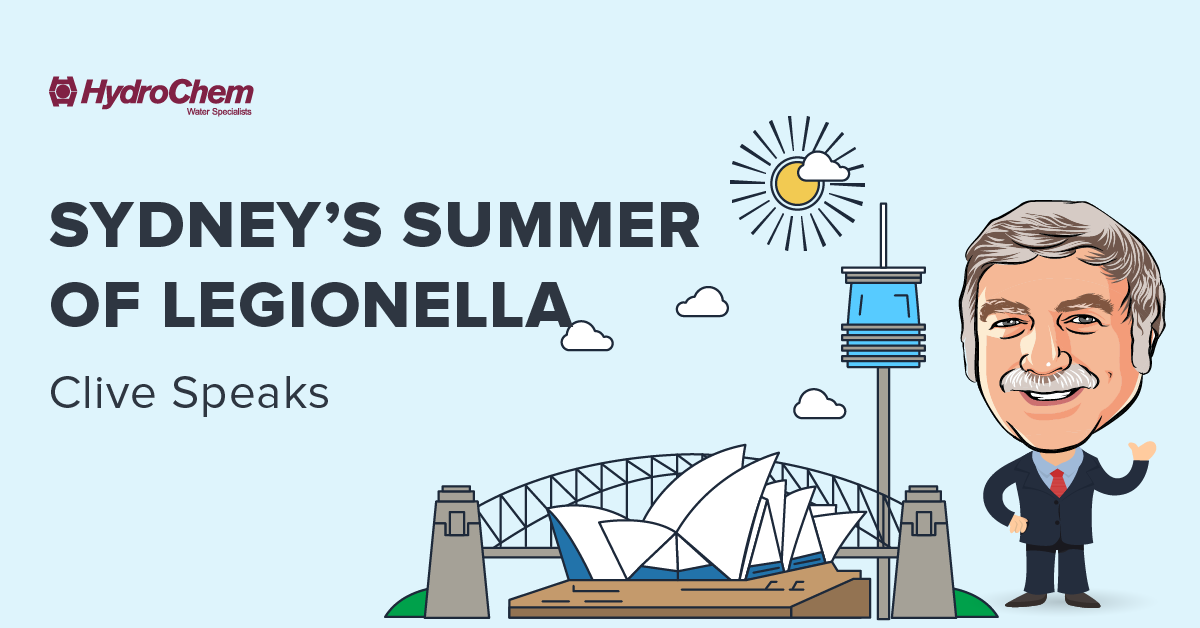Last year HydroChem sponsored a series of technical seminars along the eastern seaboard. The seminars highlighted Sydney’s deadly summer and autumn of Legionella earlier this year and touched on some of the key factors that may have contributed to the numerous resultant Legionnaires’ disease outbreaks.
Join Clive Broadbent as he discusses the control and management of Legionella both here and abroad.
Watch the video or read the transcription below.
Top three priorities in preventing Legionella. I think to be education, education, and education. There’s just so many different players in the industry need to brush up on what the subject is about, whether it’s those who are very deeply involved in the construction of cooling towers or supply of water treatment, whether it’s those who design systems. All these people and also the wider community so that they’ve got a better chance of responding to a particular situation without a panic.
Often at installation, the cooling tower is just about the last piece of equipment to be considered. And that is to say, it’s always…it’s sometimes stuck over in a corner and access is poor.
That needs the service guys to be able to access the components of a cooling tower, components of a system, components of the water treatment. It goes with any mechanical plant really but more so with cooling towers because they don’t usually come to the site already provided with ladder, step ladder for example. So sometimes that sort of facility needs to be added on site but it is just as important to see the top of the cooling tower as it is to see the bottom of it.
The relationship of Legionella detection and Legionella growth with corrosion is that corrosive product provides extra surface area for Legionella to grow on. So in terms of control of corrosion and control of Legionella, they are both compatible. And I don’t think one has any greater importance than any of the others actually because if a system is corroded out, for sure, that’s a sign of neglect and it’s a defect in the system which can allow Legionella to grow.
In terms of qualifications for water treatment service providers here in Victoria, there’s certainly regulations about such people undergoing tests and they are provided with certificates at various levels. Person who is the manager of a water treatment company versus those who are servicing the equipment, which is all very good. It is the only state that has such a requirement. But maybe the other states will follow because the record of Legionnaires disease outbreaks in Victoria in the last decade has been very, very good.
So the evidence is there for this multi-faceted approach to actually work, not only of the equipment designed properly and is located properly and operating properly but also the people who attend to the servicing also are qualified to do so. Here in Victoria, there is a management approach which is quite unique in the world, in that there’s a third party auditor involved. So there must be a risk management plan prepared for each site, each cooling order site system. However in Victoria there is also a need for an auditor to conduct a test audit.
That is to say, they gather all the paperwork associated with a particular site and a particular system. And if there are recommendations in that paperwork the question is asked, “Has this, have these recommendations been actioned?” If not, why not. That sort of thing. The auditor plays a really important part and I think Victoria has to be congratulated on introducing that concept.
In terms of our position in the world on the world stage in Legionella control, we really do lead it. The Americans in particular who are into this subject, American engineers in particular see that, I recognize that.
You might also be interested in Part Two of this series as well as more videos from HydroChem via our Youtube Channel.

